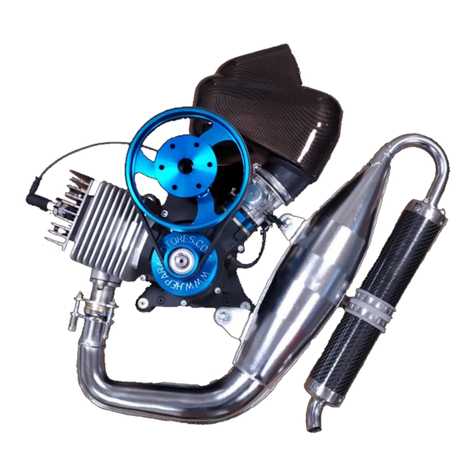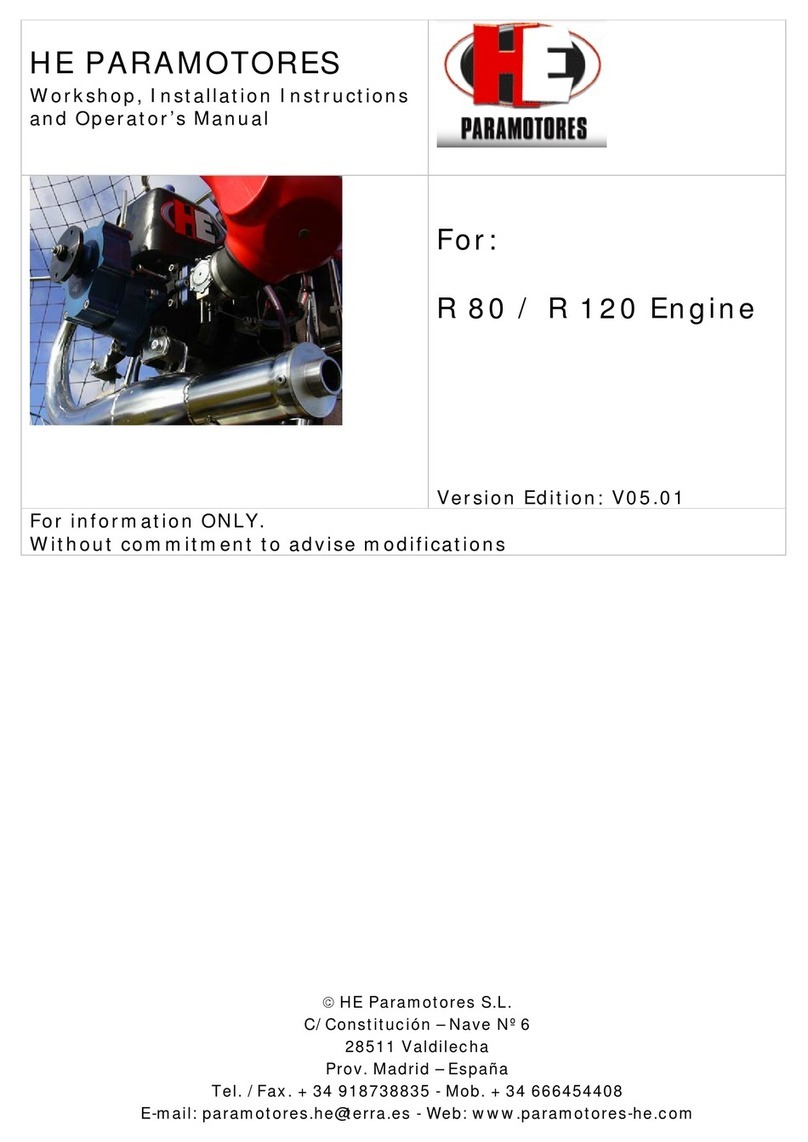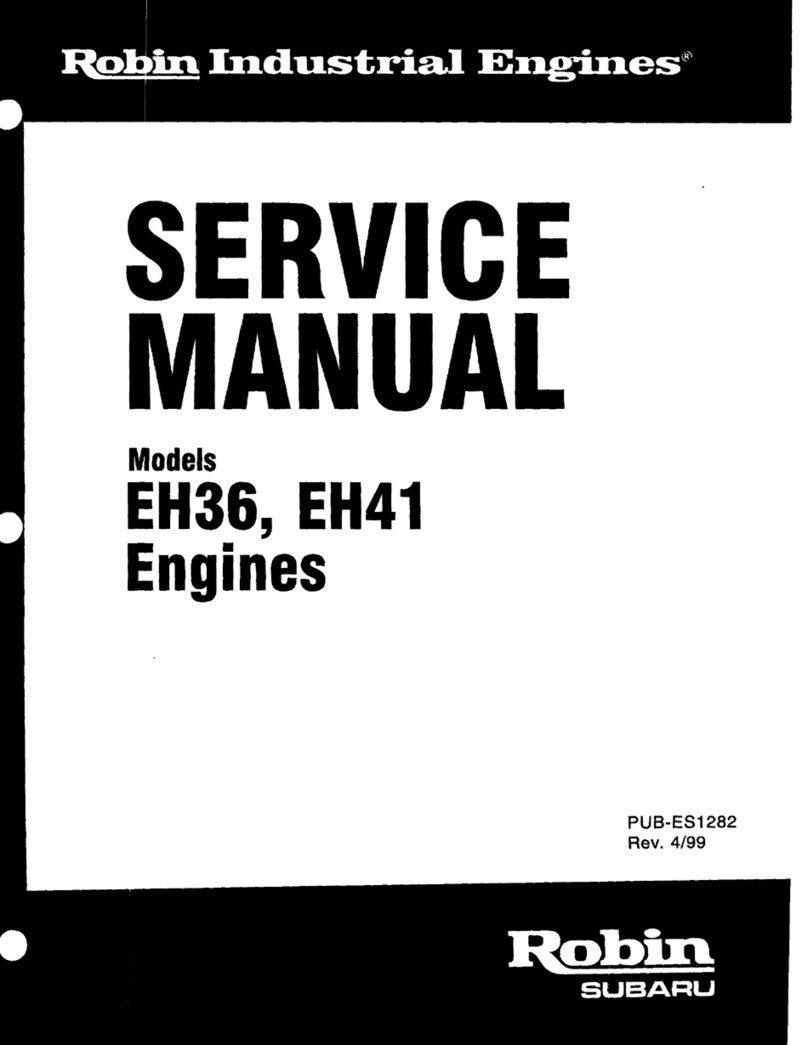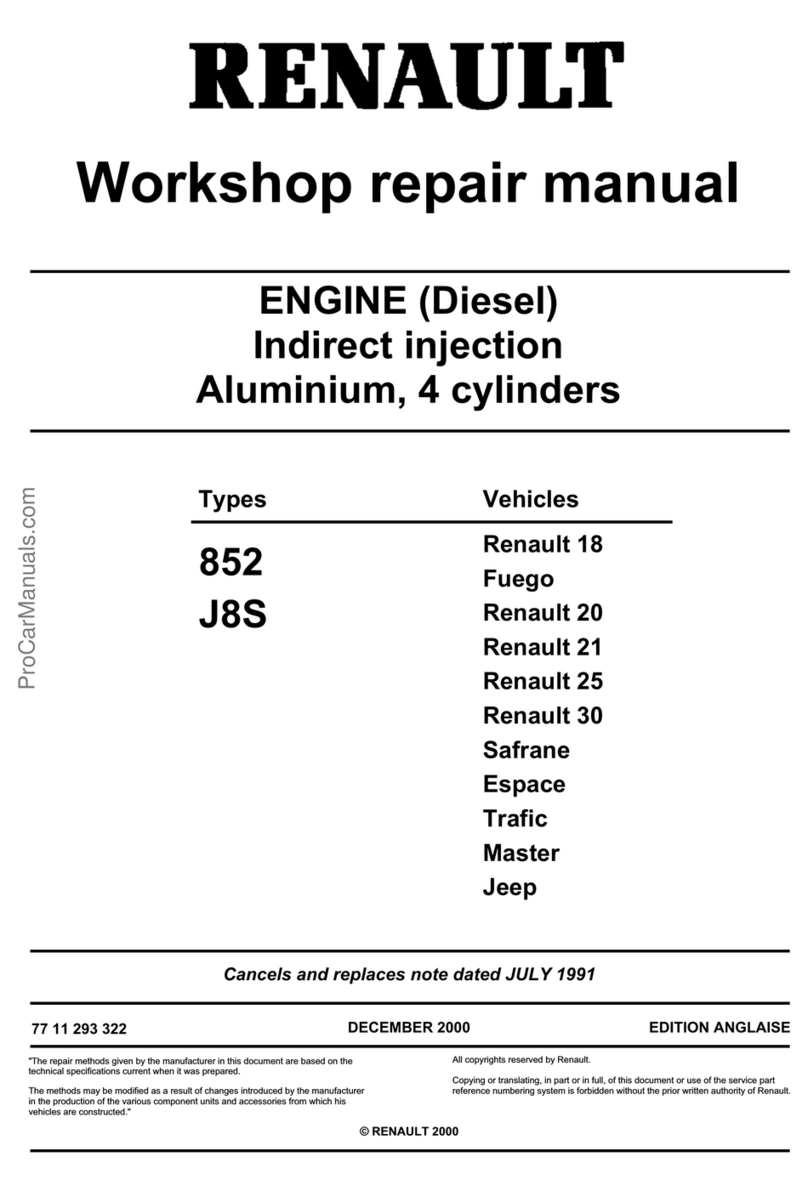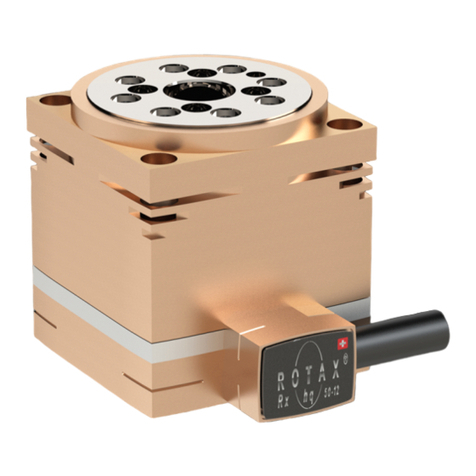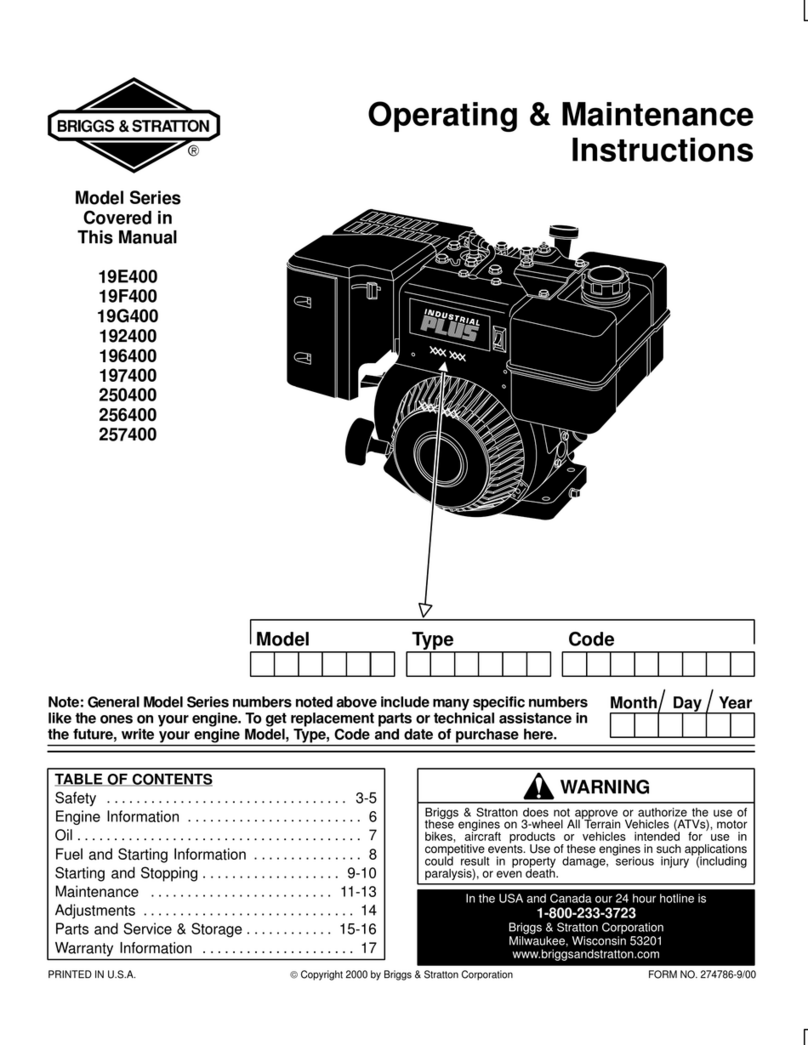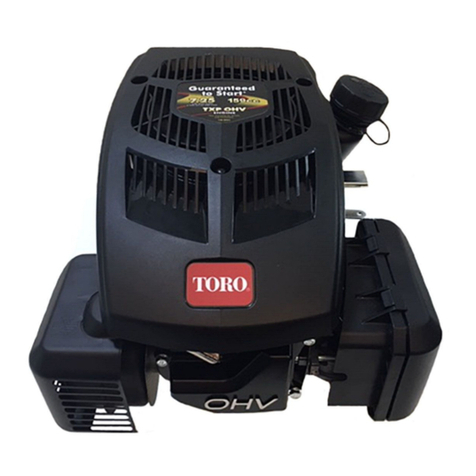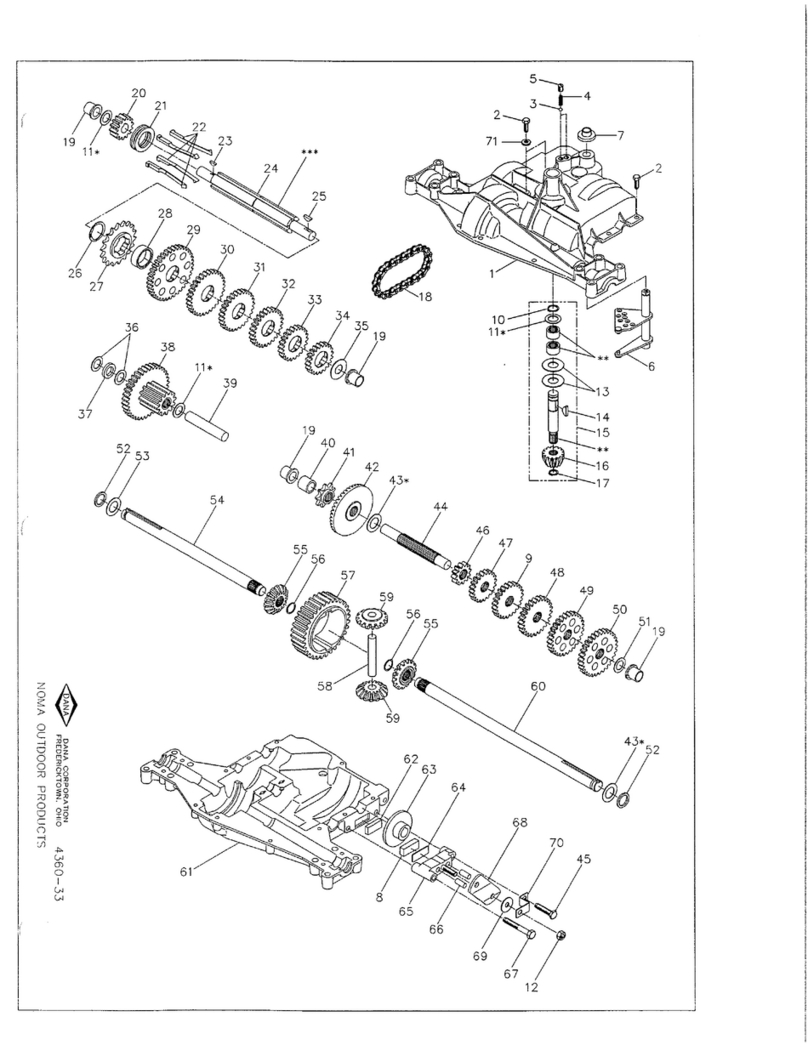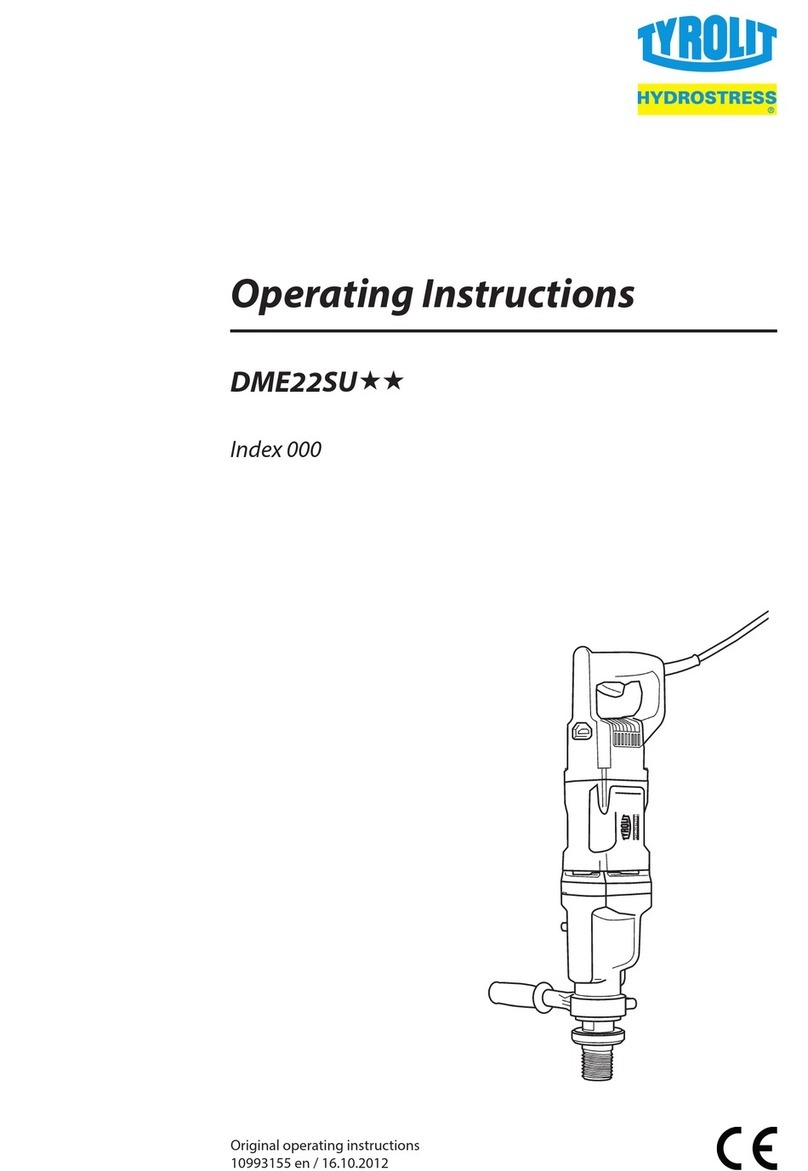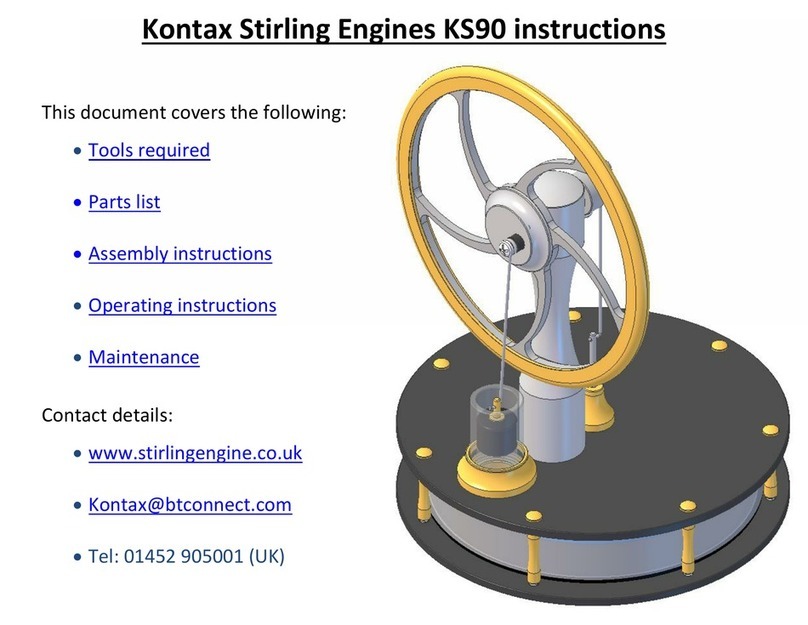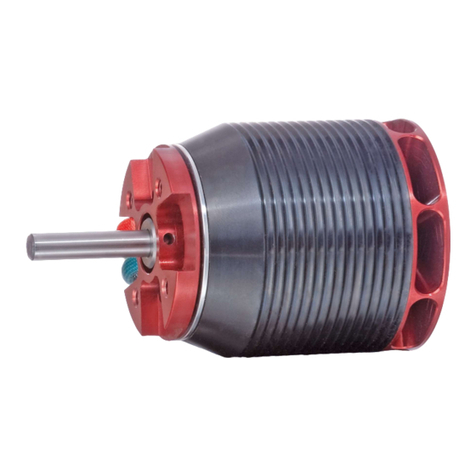HE PARAMOTORES R 220 Setup guide

HE PARAMOTORES
Wo
an
rkshop, Installation Instructions
d Operator’s Manual
For:
R 220
E
Version Edi n: V01
ngine
tio
For information ONLY.
Without commitment to advise modifications
HE Paramotores S.L.
C/ Constitución – Nave Nº 6
28511 Valdilecha
Prov. Madrid – España
Tel. / Fax. + 34 918738835 - Mob. + 34 666454408
Con encial HE Paramotores Página 1 21/03/2007fid

Confidencial HE Paramotores Página 2 21/03/2007
Preface
All ata and procedures are based on the state of knowledge at the time of
pub
how
We odification and possibility of errors.
Re nting, translation or copies in whole or in part, authorized only after
wri
nstitución – Nave Nº 6
28511 Valdilecha
Prov. Madr
Tel. / Fax. + 34 918738
E-mail: paramotores.he@terra.
d
lication and the manual has been drawn up to the best of our knowledge,
ever excluding any liability.
reserve all rights including technical m
pri
tten permission by:
©HE Paramotores S.L.
C/ Co
id – España
5 - Mob. + 34 666454408
83
es - Web: www.paramotores-he.com

Confidencial HE Paramotores Página 3 21/03/2007
Introduction
Con ing the R220 engine.
The usively for use in paramotoring,
whi g adequate oil type and fuel. You
sho also comply with all the flying rules in your country.
inst
Warning: This engine performs better as comparable products.
Re
W the
life the pilot, mechanic or third party.
Ahich if not followed may severely damage the engine.
Non ompliance might lead under certain conditions to health hazards.
N
ÖDenotes
9D
gratulations on choos
HE Paramotores engine type R220 has been developed excl
ch must only be run mounted with specific propellers, usin
uld
Warning: Before starting with installation and operation of the engine, observe the
allation instructions and Operator’s manual and follow all instructions.
peating symbols
arning: Identifies an instruction, which if not allowed may cause injury or endanger
of
ttention: Denotes an instruction w
-c
ote: information useful for better execution and understanding of instructions.
a working operation
enotes a checking operation

Confidencial HE Paramotores Página 4 21/03/2007
1. nstallation instructions for HE Engine Type R220
in
Warning: For the b peration, compliance with the following advice
reg ding installation of engine and equipment is required.
W
Warning: Besides the engine–specific installation advice, also take note of information from
the re
All gly.
The engine carton
Qty Description Application
I
a. General precaution and safety information for engine
stallation
est possible engine o
ar
arning: Modifications on engine or equipment are not allowed.
spective chassis manufacturer.
b. Engine removal from the crate
packing material should be disposed of accordin
contains the following parts:
.
1 HE Motor R220
1 Workshop, Installation Instructions and
Operator’s Manual
1 Engine identity card
1 Air filter Righetti Ridolfi -
1 ark Summer and win
spark plug
Sp plug ter
1 Exhaust system
1 Walbro Carburettor
4 Mounting sets
2 HE stickers
Subject to change
At ention: ed on a horizontal surface, take care not to dam
wiri of the st
e: An ng date of delivery, company’s n nd motor’s
iden cation
Note: The the engine identity card is required for verification of a warranty
clai . Withou entity card no warranty claim will be gr ted.
If t red to receive the HE Paramotores R220 engine,
the teel plats with two holes each are welded on the two frame tubes. The engine is
tigh
tIf engine is plac age the electrical
ng arter mechanism.
Not engine identity card stati ame a
tifi number.
data entered in
m t a completely filled in id an
c. Engine assembly
he frame of the chassis was specially prepa
n 2 s
tened into position with four 8mm bolts and four lock nuts.
You e frame by using 4 rubber mounts of 40 mm between the backcan install the engine on th
flan e and the engine mount. This device will permit to evenly distribute the vibrations of theg
engine on every part of the frame.
For the connection between the carburettor and the fuel tank use a proper hose of the right
diameter (1,2 times the max. expenditure per hour, that means sending 11 Litres/hour). The
length of the fuel line must not be more than 80 cm.

Con idencial HE Paramotores Página 5 21/03/2007f
It is advisable to install a manual primer bulb to get the fuel to the carburettor before for
starting. This device will allow the fuel to arrive to the carburettor, protecting in this way the
battery.
IMP TESORTANT NO
DO e without the propeller.NOT try to start the engin
DO h loose bolts or parts, since this can cause the detaching of theNOT start the engine wit
pro rubber mounts.peller, the ovalization of the propeller boles and the breakage of the
IMPORTANT! BEFORE FLYING CHECK ALWAYS EVERY PART OF YOUR CRAFT, FROM ENGINE TO
FRAME.
Verify that there are no damaged electric wires, that there are no leaks from hoses, tank,
carburettor or engine's crankcase, that the propeller is not damaged or loose, that the exhaust-
pip acks, that the frame is not bent or broken because of falls, that rubber mountse has no cr
are not cracked, that the reduction belt is not loose and every bolt is tight. Finally you can start
the engine, leaving it to warm up at a speed of 2.200 to 2.700 rpm with head temperature at
least 120 °C.
During installation, some safety precautions must be made (we remind you that an engine’s
vibrations, even if very small, can cause the loosening and/or removal of screws or other
obj fore necessary, to avoid any engine components, following accidentalects). It is there
det damage to people and/or things, to fasten them to the engine usingachment, causing
a s all steel cable. The components that must normally be "made safe" are:m
- The filter and the carburettor, fastened to the engine
- The engine itself, fastened to the frame, bypassing the silent block (in this case use
synthetic fibre "straps" that are particularly resistant to traction and tearing).
The spherical mouth of the exhaust pipe must be lubricated with grease that is resistant to
high temperatures (e.g. copper grease), before being inserted into the exhaust induction.
We recommend taking maximum care when carrying out these operations. In any case,
during the assembly phase the proper choices must be made by expert and qualified
per
ÖW
get supplied.
9V
Node gap of spark plug should be 0,5 mm/0,020 in to 0,6 mm/0,024 in.
Onl ight bendin
ÖFit supplied spark plug and tighten to 24 Nm/212in.lb.
ÖP
e. Installation and connection of the carburettor
ÖC eck that all the gaskets are properly fitted onto the laminar entry box and carburettor
inst
sonnel.
d. Fitting of the spark plug
ith the engine a spark plug of the type NGK BR 10 EG (summer) or NGK BR 9 EG (winter)
erify electrode gap of spark plug. Adjust as required.
ote: The electr
y sl g of the ground electrode is permitted.
ut spark plug cap or connector on spark plug.
h
allation plat.

Confidencial Paramotores Página 6 21/03/2007HE
ÖRemove the transport plug from the carburettor.
ÖF in vertical position.
ÖT
N
ÖFit the carburett
ÖA ach the intak
Nhat the best possible
pos
To -counter is required for
observation of the speed limits.
Note: HE Param ment: Tiny-Tach
inductive rev unter.
N
the for engine speed (r.p.m.) will be displayed). This
disp y will remain on for 5 seconds after engine stop.
Ahe manufacturer’s notes about connections and operation of the
inst ment.
A
cou
Wind at least three turns of the inductive cable between the ignition coil and spark plug
conne
Atta ent with cable ties for highest visibility and lowest inconvenience on the
har s or chassis.
A
ÖS cure induction cable with cable ties on the frame.
Amage the cable
or c
W peration, read the Operator’s Manual.
it carburettor into carburettor socket and secure with hose clamp
he R220, connect the outlet hose of the fuel pump with fuel inlet on carburettor
ote: each time this operation is conducted make sure to use a new set of gaskets.
f. Installation of the Righetti Ridolfi Air Filter / silencer
or socket 1into the Air filter hole.
e silencer with the supplied hose clamp 2on the carburettor.
tt
ote: the carburettor socket is asymmetrical and can be turned so t
ition for maximum leg clearance can be achieved.
g. Observation of the engine speed.
determine the best possible transmission ratio, the use of a rev
otores offers as an accessory the following indicating instru
co
ote: This instrument is operating via an integrated battery. At engine start the readings of
onnected sensors (inductive pick-up
c
la
ttention: Pay attention to t
ru
ttention: Use the original spark plug of 5 k resistance, so that the operation of the rev
nter is not impaired.
ctor and secure it with a cable tie on the ignition cable.
ch the instrum
nes
ttention: Use a vibration damping pad between the instrument and tightening spot.
e
ttention: The induction cable must be free of tensile stress; stress could da
uld result in the malfunctioning of the cable and the instrument.
o
arning: Before engine o

Con encial HE Paramotores Página 7 21/03/2007fid
MAIN TORQUES and settings
De ription Kg.m (Nm)
sc
DEC 2,0 20OMPRESSOR
NUT 2,2 22S TO FIX THE HEAD
NUT
CRA 2,5 25S TO FIX HALF-
NKCASE
BOL
FLA 020TS TO FIX THE BACK
NGE TO THE CRANKCASE 2,
NUT STON TO
THE
DRI
4,5 45S TO FIX THE PI
FRONT PART OF THE
VE SHAFT
NUT
ORI
HAN
ver
35S TO FIX BACK PART OF
VE SHAFT TO IGNITION
DWHEEL (manual
sion)
3,5
6x4 120 Screws 1,2
Connector 1,0 10
Spark plug 1,8 18
instructions for H gines type R220
nical description he HE engines type R220
i. Type of engine
Single c ed
by addin
Eas nual start system with placed for over shoulder start.
Wa o WB37 (report to the Walbro user manual for any specific information).
Report to engine tuning se
iv. Intake silencer
The take silencer incorporates an air filter to clean the intake air. The intake silencer has been
desi ned for optimum re oise level and represents a tuned system
with he engine.
The ter muffler and represents a
tun system with engine.
2. Operating E en
a. Tech of t
ylinder two cycle engine with reed valve controlled inlet. Mixture lubrication is achiev
g oil to the gasoline in a specified mixing ratio.
ii. Ignition unit
y ma internal decompressor:
iii. Carburettor
lbr ction for tuning details.
in
gduction of the air intake n
t
v. The exhaust system
e
edxhaust system is designed as resonance system with an af

Confidencial HE Paramotores Página 8 21/03/2007
b. Fuel as media for engine operation
The R220 engine is designed to function with a GASOLINE/OIL mixture.
Use icfor the mixture only premium fuel for cars 95 octane, together with good- quality, synthet
oil for mixtures at a quantity of 2,2% .(DO NOT USE MIXTURE ALREADY DONE AT PETROL
PUMPS). IMPORTANT: with very hot climate and high temperatures use PERCENTAGE 2.2%.
When you prepare the mixture, make sure that the can has not dirt or water in it, put always
the oil first and mix thoroughly.
Never run the engine without the air-filter, because dirt and dust raised by the propeller can
dam
Am
age it.
ount of oil for a given amount of petrol:
R220
Befo
(Tw 2,5 % of the amount of unleaded petrol (U.P.) 95
with fully synthetic 2 stroke oil (e.g. CASTROL TTS).
re 6 hours
o 9L full tanks)
Aft 5 with fully synthetic 2
er 6 hours 2,2 % of the amount of U.P. 9
stroke oil.
ÖP f fully synthetic 2
ÖA trol 95 to
Ach oil in the fuel m
exhaust valve).
A
pist
Warnin amage to the
inta
W ng fuel and fuelling do not smoke or allow naked flames. Petrol is highly
flam able and explosive under certain conditions.
W
are
N
ÖS r.
ÖP
ÖC
Warning: Before each fuelling, shake well fuel container to ensure adequate mixing of the
gas
W the paramotor only when engine is not running.
W ine components or equipment.
Risk re and explosion!
W or manufacturer!
our small amount o stroke oil in a clean fuel container.
obtain a good mixture.
dd amount of unleaded pe
ttention: Too mu ixture could lead to engine trouble (e.g. cooking of the
ttention: Insufficient amount of oil in the fuel mixture could result in engine trouble (e.g.
on seizure).
g: Do not try any different sorts of fuel. This could lead to engine d
ke system.
arning: When mixi
m
arning: Never perform mixing and fuelling in a closed room, handle fuel in well-ventilated
a only.
ote: Do not fill the fuel container to the top.
ake well fuel containe
h
our fuel into fuel tank of the paramotor,
lose fuel tank and fuel container immediately after fuelling.
oline with the oil.
arning: Fuel
arning: Make sure that the fuel will not splash onto hot eng
of fi
arning: Pay attention to the safety advice of the paramot

Confidenci sal HE Paramotore Página 9 21/03/2007
Attention: Don’t spill fuel. Absorb spilled fuel with appropriate drying agent and ensure
eco
Acontamination enters the fuel tank and the carburettor.
logical disposal.
tention: Ensure that no
t
Attention: Unleaded fuel has a limited storage life. Store only the quantity of fuel in a
con iner which will be needed in the near future.ta
Attention: Do not use vegetable or animal oil.
A
i. Carburettor
ttention: DO NOT MIX DIFFERENT TYPES OF OIL TOGETHER.
c. Engine tuning
Warning: It i the carburetion operations with the ENGINEs recommended to carry out
SWITCHED OFF!
The engine is carburetted ering; do not try to modify the carburetion
if y
A "f ces more vibrations and increases consumption.
Wit
"bla
wit ached when the insulator of the spark plug is coffee brown;
if the colour is black, the mixture is too rich, therefore turn screw H clockwise 1/8 round per
tim
clockw
CAN
sec
in the factory before deliv
ou do not know how.
ull rich mixture" produ
h a "lean mixture" the engine is more even but it gets overheated (usually there are
nks" in the carburetion). After 10 minutes of working, the spark plug will start to get dirty
h fuel waste. Ideal mixture is re
e. If the spark plug is grey/white, the mixture is lean, therefore turn screw H and L counter
ise always 1/8 round per a time. Remember that if the mixture is too lean, THE Piston
SEIZE. You can see better the colour of the spark plug by keeping the engine for 20
onds at maximum speed and switching it off suddenly without letting it slow down.
spark plug colour yellow/grey hazel brown/light
brown brown/black
carburetion lean right rich
Dia
In order to work properly, the diaphragms (pump and valves) must be kept wet by the fuel
mixture, after uel o working m
need to be repl plea h with ay
necessary every year, the use of old diaphragms leads to an increasing l the mixture
and piston seizure. In some cases it may be necessary a seasonal carburetion setting,
especially if you de, for such please do turn to an e
ult start, while revving up the engine tends to stop
phragm carburettor
a long resting without f
aced. In case of doubts r after several
se do get in touc hours the diaphragms
us. The replacement m
eaning of
ay
be
change of altitu a setting xpert.
idle too lean : Diffic
idle too rich : The engine abates while leaving it at idle for ten sec. and it
revs up slowly, excess of smoke.

The Walbro WB37 carburettor, if used correctly, provides excellent performance,
requiring few tuning interventions. In any case, changes in climatic and height
conditions can affect functioning. The carburettor is adjusted during the testing phase
with
The carburettor is used in the priming process before starting a
cold engine (Push cautiously! Go to section 2. e.).
At
turn ure,
while the opposite you lean it. The basic setting is between one
and
ver
fly,
pos
the
At
turn
whil
Lsc
The n
plea ise
dire
a standard setting:
little hole Dat the front of the
Confidencial HE Paramotores Página 10 21/03/2007
high revs, you can set the carburetion at the desired R.P.M. By
ing the long black screw Hanticlockwise, you rich the mixt
half turn from the shut position. The Hscrew must be turned
y gently. According to the environment in which you are going to
the A screw can be opened or closed from the recommended
ition a quarter of a turn (by the sea side, closed a quarter down, in
mountain, opened a quarter up)
low revs, you can set the carburetion at the desired R.P.M. By
ing the small black screw Lanticlockwise, you rich the mixture,
e the opposite you lean it. The basic setting is half a turn from the shut position. T
rew must be turned very gently.
H
C
L
D
eh
C screw sets the revs at idle, by opening the butterfly valve (for additional informatio
se contact your local distributor). If the idle is high, turn the screw in an anti clockw
ction. If the idle is low, turn the screw in a clockwise direction.
Bea mring in mind the fact that the first testing is carried out at a height of 750
above sea level, it may be necessary to change from this setting, without exceeding
the limit regulations: Screw H - do not go below one turn or "360°". Screw L - do not
go below l/2 turn or “180°
The carburettor is provided with a depression pump to remove the fuel from the
tank. The gap between the two must not exceed 50-60cm. The same applies to the
tube, which must not exceed 50-60cm.
It is advisable to insert a manual pump between the tank and the carburettor, so that
the mixture can reach the carburettor before start-up, therefore avoiding stressing
the
Fur
tha
and
cha r screws can be damaged by continuous
adj
starter motor.
thermore, we advise to put a small security-cable on the air filter, on the muffler, to avoid
t it can come off. These adjustments can be different on the basis of weather conditions
flight altitudes. Once you have found the perfect mixture do not change it unless you
nge flight place or climate conditions, since registe
ustments.

Confidencial HE Paramotores Página 11 21/03/2007
ii. TENSION OF THE REDUCTION BELT DRIVE
USE CAUTION Attention: a belt which is "over tensioned" can do permanent damage to the
bearings inside of the pulley hubs and drive shaft. Therefore we strongly suggest for you to
follow carefully these instructions.
Before adjusting the belt take a felt pen or marker and make a small sign on the cam shaft and
on Zero or start point and from here you will bethe front of the reduction plate. This is your
able to clearly see how much you move the eccentric tensioning cam in relation to the reduction
plate. Remember "these are Fine adjustments" and we suggest not rotating the cam any more
than 1 mm per adjustment. After each adjustment you can try to start the engine and check
the result. If the engine does not start well then it usually means the belt is still too loose and is
slipping - in this case repeat the operation by tensioning the belt another 1 mm. Consider that
if the belt slips a little, but the engine still starts fine, then the tension is correct. Belt tension
always unreleased automatically when the engine is running because of thermal expansion in
the pulleys. Once you have found the correct tension, do not adjust it any more. In case of
dou
Ref. HE Name Description Quant./
unit
bts please contact your paramotor dealer - or HE Paramotores.
iii. Propeller
Propeller Carb for R220 H30F 1,25m L-M 07 - 02 x1
HEL0003 Propeller for R220 Wood 48x24 L x1
Only the propellers listed e been properly tested and are adapted to our
motors.
At Never run y ne without an adeq fitted! Yo damage
your eng e.
W r e prop on!!! Never o te an engine
with prop if not properly fitted onto an adapted chassis and without a frame securing you from
the
not operate engine with propeller if you have not followed a certified
paramotoring course and are not qualified to handle these machines.
W amotores does not take any responsibility for bad handling and dangerous
behav ines.
pur
in the above table hav
tention: our engi uate propeller u may
in
arning: Take care whilst operating you ngine with pera
propeller.
Warning: Do
arning: HE Par
iours with its eng
Attention: HE engines type R220 have been developed only for paramotoring
poses. Any other use will not be covered by the engine’s guarantee.
To atta lts of class 10/8 (100 Kg) and make sure that their length isch the propeller use only bo
enough to exit from the reductor-pulley. Tighten the 6 bolts M8 in a cross, at 1.5 Kg.m.
(15Nm). Re-check the torque of the bolts after the first hour of engine's working.
We suggest not using a variable pitch carbon prop. because the big hub pushes the prop too
forward, with possible damages to pulley and bearings.

Confidencial HE Paramotores Página 12 21/03/2007
iv. Characteristics and Operating limits R 220
Cycle 2 strokes
Tota nt 218 c.c.l displaceme
Bor 65 mm.e
Stro 52 mm.ke
Com n ratio 10:1pressio
Pea 7.480 rpmk rpm
Coo by airling
Pist of light alloy wi on ring of cast iron
S10 chrominiu
on th 2 pist
m-plated
Cyli Nikasil Coatednder lining
Hea die-casted ligh
silicon
d t alloy with high percentage of
Crankcase CNced Hard aluminium
Con of steel 18 Ni C
plated with rol
necting rod r Mo 5 forged and Copper-
ls fit for high speed
Carb Diaphragm – Wurettor albro WB37
Feed reed valve withing 4 petals on the crankcase
Reg k advance 15° with electrulation of spar onic ajustment
Spa NGK B9ESrk plug
Reduction with belt Poly-V 1 to 2.6
Cyl erature max 170°Cinder head temp
Fue mixture of prem
unleaded and o
lium petrol 98 or 95 octane
il at 2%
Oil synthetic top-quality oil for 2-strokes engines
Exp from 2,5 to 7,5 ending from the
load and the sp
enditure litre/hour dep
eed
Fixi 4 rubber anti-vng to the frame ibration mounts
Rot anticlockwise i lleration n front of the prope
Warning: The engine is only allowed to be run at peak
spe d operating temperature of 160 °C.
Warnin aximum operating temperature of the engi
temperat 240°C), it may result in piston s
Nd at regular intervals to achieve th
A eep your engine clean at all time!!!
performance after reaching the
cified the specifie
g: The m ne must not be exceeded. If the
eizure.
ure is too high (above
ote: Dirt must be cleare e best cooling performance.
ttention: K

Con 21/03/2007fidencial HE Paramotores Página 13
d. Engine start and operation
Prior to engine start verify the following:
9throttle cable is not jammed
open! Do this by squeezing the throttle lever and allow it to release sharply. Look
aro
oth
ma d in fractions of a second when no load is applied. It is
not equipped with a rev limiter and the mechanical parts are only designed to work at the
rot
on t
9F
STA GINE
If the eng ted for the first time, or it has run out of fuel you will need to prime
the press the short, fitted wire prod through the hole in the centre of the
pla on the propeller side of the carburettor whilst simultaneously squeezing the pump bulb.
Thi fuel filter and into the carburettor. Squeeze the bulb
just h the clear filter. Stop, pull the wire prod back and
gen
cho
cho
ove
the
N
star
the
sho
don
and
floo
many times you pull the chord (!) If the engine has become flooded, simply remove and wipe
clea
STA
Fol
The
bef
Pre
W
Before starting the engine, ALWAYS check that the
und and make sure there is no one nearby and SHOUT “Clear prop!” to warn
ers of your intentions.
Warning: Never start the engine without the propeller!! A two-stroke engine has a low
ss and its maximum speed is reache
ation speeds reached with the propeller. Exceeding this speed will have catastrophic effects
he engine.
uel tank full,
RTING A COLD EN
ine is being star
fuel system. Gently
te
s allows you to push fuel through the
e and watch the fuel pass throug
onc
tly squeeze the bulb again. The carburettor is primed. When starting a cold engine pull the
ke wire towards you, then start the engine and wait until it stops running. Then return the
ke wire to the neutral position and start the engine again using a little throttle then let it tick
r until warm. The engine will normally start without any problems unless
outdoor temperature is very low. In this case repeat the use of the choke.
ote: To avoid damaging the starter mechanism, always use the starter as follows: hold the
ter handle with one hand, brace yourself against the frame with the other and gently pull
starter feeling for the point of maximum resistance. Once there, give the starter cord a
rt sharp pull. Normally the engine will start up immediately. If the engine does not start,
’t keep pulling the starter, it will not help and it could even be dangerous. Save your energy
find the source of the problem. It is nearly always an excess of fuel – the engine has been
ded. Over zealous use of the fuel primer pump will flood it and it won’t start no matter how
n the spark plug. Tip: use a cigarette lighter to burn off the excess fuel on the spark plug
RTING A WARM ENGINE
low the same procedure as before but do not use the choke.
engine needs to reach its working temperature – allow it to warm up for at least a minute
ore revving it.
e. Stopping the engine
ss the Kill switch button for more then 3 seconds.
arning: If not, you engine will restart.

Co 21/03/2007nfidencial HE Paramotores Página 14
f. Running in procedure for the engine
All HE engines, before being delivered, are subject to a severe quality-check, in order to verify
if all the components respect the fixed parameters, but a further running-in is anyway
necessary. A GOOD RUNNING-IN WILL PROLONG THE LIFE OF YOUR ENGINE.
Go to a quiet place, put a thick rubber carpet under your craft to avoid that stones or other
thin damage the propeller by putting it on earth and let the engine work at a speed of 2500gs
rpm for 5 minutes, and then regulate speed at 3000/3500 rpm for 15 minutes, then at 4000
rpm for other 15 minutes. Switch off the engine and check that there are no loose nuts or bolts
and that every component is ok. BE CAREFUL NOT TO TOUCH HOT PARTS (POWER UNIT AND
EXHAUST PIPE). Start the engine again and take it step by step to 4000 rpm for 5 minutes,
then accelerate to 4500 rpm for 15 minutes. During the first 10 hours, do not subject the
engine to extreme efforts and speed. Also during normal use excessive loads (ex. tandems with
passenger) can force the engine with possible damages to the engine itself. ALWAYS CHECK at
sight your craft before and after every flight, for loose parts or damage. After each flight, clean
the head from possible oil residues. During the run-in period vary the power often for a proper
pist
It is
not
imm
nois
the e slack and should be checked – do not over tighten them! Don’t
mistake overheating for poor carburettor adjustment or dirt in the filter both of which may also
cau
W
pro
W
ope
Warning: During operation beware of body or clothing contact with propeller or engine!!!
W
Warning: art prone to wear before and after each flight in accordance with the
directi
W edure as directed.
W
Warning: Never engine with an empty fuel tank.
Note: To start with do not operate your engine for longer periods then stated above.
N
Note: Do not rev. up for five minutes while running-in.
on ring setting.
possible that the engine may overheat during the running in period. If this happens you'll
ice a loss of thrust and you should switch the engine off and let it cool down, or at least,
ediately reduce the revs. An overheated engine can usually be detected by back firing
es or by oil stains on the cylinder cooling fins. If the engine should overheat the bolts on
cylinder head may becom
se a loss of thrust.
arning: Always wear appropriate clothing to operate your paramotor (Helmet, gloves,
per shoes…).
arning: Do not touch the engine, the exhaust system during and immediately after motor
ration. Risk of burning!
arning: Comply with the safety advice of the paramotor manufacturer.
Inspect any p
ve of the paramotor manufacturer.
arning: Keep the running-in proc
arning: operate engine only in the specified limits.
ote: You must run-in the engine before flying.

Confidencial HE Paramotores Página 15 21/03/2007
Note: The lifespan of your engine can double with a proper running-in, while with a bad one
you
Not on and off following
the cycles below:
eng cle 2° cycle next
may damage it since the very first hours of working.
e: In the first phase of the running-in the engine must be switched
ine 1° cy
on
off
2
minutes
2
minutes
5 10
inutes.
minutes
5
minutes
minutes
5 m
Note: While on, the engine ust be gen et at diffe ting from the lowest up
to the highest.
Warning: Repeated revving are unsuitable, the clutch may be surcharged.
Afte
After at least 30 minutes of work you can fly avoiding high revolutions for too a long time.
A heavy pilot requests more power to fly, in such a case is better to run the engine on the
gro
After the first 30 minutes of run, do check all the bolts, knots and screws, particularly those of
the
5 hours of flight.
Eng
In this case is very dangerous to keep it on, it is better shutting off and let cooling, OR, AT
LEA
bec
for
In case of overheating it is advisable to check the head screws to verify the seal of the motor
hea
by o
W
MAINTENANCE - BEFORE EVERY FLIGHT IT IS IMPORTANT THAT YOU;
9C
ma
eng
9Check that the ex ld in place and that it is not damaged; check that
all of the engine p ttor, petrol tank and pipe, spark plug and starter
cable are fitted correctly and are secure. Check that nothing can come loose in flight because if
anythi le.
m tly s rent revs, star
r each switching off, do carefully check all the mechanic parts, bolts and knots.
und for at least 1 hour.
engine and the prop as well. Those of the engine (bolts and knots) must be checked every
ine overheating may occur while running-in; you can recognize it by a loss of power.
ST SLOW DOWN BELOW 5000 RPM before applying more power. A loss of power may occur
ause a mixture too lean, following a wrong carburettor setting or dirty in the filter, do check
such possibilities before restarting the engine
d, see locking torques. Usually a loss of seal can be perceived by dull strokes at starting or
il leakage, once the air conveyer is removed.
g. Maintenance
arning: Change lock nuts for new ones if untightened!
heck that the propeller is not damaged, that it is secure and that it turns smoothly without
king noises. BE CAREFUL - never be tempted to put your hands in the paramotor once the
ine is started even though the propeller is not moving.
haust pipe is correctly he
arts, air filter and carbure
ng hits the propeller it will be a danger for the paramotor, the pilot and other peop

Confidencial HE Paramotores Página 16 21/03/2007
9Check the welding on the chassis, especially where the engine is located. Check that the
net
pro
A
Wh f oil and dust from the engine and
the oblems.
ting is securely held in place. Check that none of the paraglider lines are in the way of the
peller and that nothing else can be sucked in.
ttention: If in doubt, do not take off!
en you have landed, use a clean cloth to remove traces o
eller. This is the best way to discover any potential pr
prop
- Every 20 hours:
Check the condition and gap (0.7 mm) of the spark plug
Cle the air-filter, the carburettor filter placed at the end of the fuel pipe and the filter of thean
fuel tank
Check the torque of every bolt
Tighten head nuts (in cross order) with a Torque Wrench at 2.2 Kg.m (22Nm)
Check the tension and condition of the reduction belt
Check fuel lines
Check the wiring
Check that the cord of the starter has no abrasions
Gre with lubricating copper-ase the link-sphere between the manifold and the exhaust pipe
gre temperature (up to 1100°). If you can't find it on the market, pleasease suitable for high
ask to your dealer.
- Every 50 hours
Same controls of the 20 hours and furthermore:
Check the torque of the engine's crankcase nuts
Change spark plugs
Change the petals of the reed valve
Che the play of the pulley and change them in case of needck the reduction belt and
Onc ly from flight hours) change the diaphragm of the Carburettor.e a year (independent
N.B book for the engine. It is also. It is advisable to keep records of all maintenance in a log
adv erature at sight.
We s with more than 200 working hours should be factory
ove eteriorated parts.
For l
pre
ÖD
no
ÖC
ÖApply oil on exh
In case the engine is not used for a long time, act like this:
ÖE ank, included the fuel lines and the carburettor
isable to install an instrument (CHT) to control the head temp
recommend that engine
rhauled in order to replace any possibly d
h. Preservation of engine and equipment
ong periods out of operation (winter time), make sure that the engine will be properly
served.
etach carburettor, drain fuel from fuel system and close carburettor openings to ensure that
dust or dirt can enter.
lose intake and exhaust port of engine so that they are air tight with adhesive tape.
aust systems to prevent corrosion.
mpty the fuel t

Confidencial HE Paramotores Página 17 21/03/2007
ÖUnscrew the spark plug and pour into the hole a teaspoon of oil for engines, then re-install
the
ÖD
ÖL
ÖP
ÖCov y place
ÖOnce a month, let the pinion of the drive shaft turn by hand 2 or 3 times completely.
i. Trouble shooting
spark plug letting the propeller turn slowly by hand for 2 or 3 times completely.
isassemble the propeller
oosen the reduction belt
lug the hole of the exhaust pipe
er everything with a blanket and put it in a dr
THE ENGINE DOES NOT START Check:
Switch on-off
Cable of the spark plug
Correct spark plug gap
All the connections of the electric plant
Tha f y from the tank to the carburettort uel arrives correctl
FLOODED ENGINE
Dismantle the p re re-assembling it, let the propeller turn slowlys ark plug and dry it well; befo
2/3 times.
THE ENGINE DOES NOT HOLDIDLE SPEED OR HAS AN IRREGULAR
SPEED
Cle ettor. Check the reed valve petals are closing completely. Hold thean and adjust the carbur
reed up to a light and you should not see any light past the petal seating area.
THE ENGINE CANNOT REACH MÁXIMUM SPEED
Check cable pulling throttle fully open.
Che uel pipe,ck that there is neither dirt in the carburettor or tank-filter nor restrictions in the f
due ht curves, or air bubbles.to too tig
Check the spark plug; is it's worn, change it with one of the same brand and same heat range.
In case the head is dismantled to be decarboned, change both the head gasket and the cylinder
gasket.
THE DECOMPRESSOR REMAINS BLOCKED
Det ct inside 1 or 2 drops of detergent. Detachach the gum tube on the decompressor and inje
the spark plug cap and let the prop turn. If this is not enough, disassemble the decompressor
wit ameter with a lathe. Remove encrustmentsh a tube wrench of 15, modified in the external di
from the decompressor and by reassembling it, tighten it at 2 Kg/M or 20 Nm with a
dynamometric wrench.
SOM FINAL IMPORTANT ADVICEE

Con 21/03/2007fidencial HE Paramotores Página 18
NEVER switch on the engine with people near propeller, or to sides. The BREAKAGE of a
propeller can cause very severe hurts even several metres away. DO NOT keep engine at peak
rpm after the take off, except for the absolutely necessary time and for emergencies (obstacles
or sudden wind). If you use big propellers, REMEMBER that cooling is not perfect flying at high
speed, so keep under control the temperature of the engine with proper Instruments (CHT). In
addition, dismantle the propeller at regular intervals and check that it is perfectly balanced,
since an unbalanced propeller, even slightly, creates micro-vibrations which are not felt by the
pilot, but can damage seriously parts of the engine with consequent breakages. Please do NOT
forget that the propeller has mass and a considerable inertial movement, so it's advisable not
to vary suddenly the RPM of the engine, both in flight and on the ground. These sharp and
violent stresses could cause damages to the reduction, to the engine, to the belt and also
possible deformations to the fixing boles of the propeller. Once you have found the perfect
carburetion, DO NOT modify it unless you change flying place going to much higher or lower
altitudes or unless climate and temperature are very different from the ones where you fly
usually. DO NOT FLY in bad weather conditions, you'll fly the day after. REMEMBER: FLIGHT IS
FOR
a. Warranty conditions / Warranty card
i. Period
HE Par facturer, warrants directly or through their authorized
HE Paramotores distributors from the date of sale to the first consumer, every
HE Paramotore d by an
authorised HE Paramotores distributor for a period of the earliest of:
Note: 6 consecutive owners;
net
The authorized HE Paramotores distributor will, at its option, repair and / or
rep normal
use and service, with a genuine HE Paramotores component without charge for
par
bec
iii. Condition to have the warranty work performed
You must present the authorized HE Paramotores service-centre, the hard copy
of
del
FUN, NOT FOR RISKING YOUR LIFE! HAVE A GOOD FLIGHT AND ENJOY YOURSELF.
3. Warranty
amotores as manu
s R220 engine, sold as new and unused, and delivere
months for private use
Note: or 12 consecutive months for engines bought through our distributors’
work.
ii. What an authorized HE Paramotores distributor will do
lace components defective in material and/or workmanship under
ts or labour, during said warranty period. All parts replaced under warranty
ome the property of HE Paramotores.
the HE Paramotores warranty registration card and/or proof of purchase
ivered to the customer from the selling dealer at the time of the purchase.
iv. Exclusions – are not warranted

Con es Página 19 21/03/2007fidencial HE Paramotor
Note: Normal wear on all items
Note: Replacement parts and/or accessories which are not genuine HE
Par
arts other then genuine HE
Paramotores parts.
failure to provide proper maintenance as detailed
in t e labour, parts and lubricants costs of all
maint
the
nal accessories installed on the paramotor engine (the normal
warranty policy for parts and accessories, if any, applies).
Note: Damage resulting from running the paramotor engine without a
pro
not
approved in writing by HE Paramotores.
Note: Cold seizure and scuffing.
ramotores.
Note: Use of propeller not referenced by HE Paramotores.
Note: Losses incurred by the paramotor engine owner other then the parts
and unting and dismounting of the
engin portation, telephone calls, taxis
and
No
or
wa
Expressed or implied warranties
amotores parts and/or accessories.
Note: Damage resulting from the installation of p
Note: Damage caused by
he operator’s manual. Th
enance services, including tune-ups and adjustments will be charged to
owner.
Note: Paramotor engines used for racing or commercial purposes.
Note: All optio
peller.
Note: Damage resulting from modification of the paramotor engine
Note: Damage caused by electrolysis.
Note: Use of gear reduction not designed by HE Pa
labour, such as, but not limited to, mo
e from the paramotor, loss of use, trans
any other incidental or consequential damage.
te: Damage resulting from accident, fire or other casualty, misuse, abuse
neglect.
Note: Damage/rust/corrosion/premature wear to the engine caused by
ter ingestion.
Note: Damage resulting from sand/stones infiltration.
Note: Damage resulting from any foreign material ingestion.
Note: Damage resulting from service by an unqualified mechanic.
v.

Confidencial HE Paramotores Página 20 21/03/2007
This warranty gives you specific rights, and you may also have other legal
rig
app
wa
any
the
sta
las
Ne
aff contained in this
warranty, and if made, such affirmation, representation or warranty shall not
be
HE
bei
app
If a
Note:
Note: Authorized
Wa n card as
soo t to the
authorized Distributor
net erated.
viii. W
sto
bod
Ne
alt
cannot be made, af ppage.
Paramotors equipped with this engine should only fly in daylight VFR conditions.
saf
in ors and vehicles only in which an engine
failure will not compromise safety.
hts which may vary from state to state, or province to province. Where
licable this warranty is expressly in lieu of all other expressed or implied
rranties of HE Paramotores, its distributors and selling distributors, including
warranty of merchantability or fitness for any particular purpose; otherwise
implied warranty is limited to the duration of this warranty. However some
tes or provinces do not allow limitations on how long an implied warranty
ts, so the above limitation may not apply.
ither the distributor, nor any other person has been authorised to make any
irmation, representation or warranty other than those
enforceable against HE Paramotores or by any other person.
Paramotores reserves the right to modify its warranty policy at any time,
ng understood that such modification will not alter the warranty conditions
licable to paramotor engines sold while the above warranty is in effect.
vi. Consumer assistance procedure
problem or other difficulty occurs, please contact:
Authorized HE Paramotors service centre or,
HE Paramotors distributor.
vii. Validity
rranty will only be valid if the end-user completes this registratio
n as the paramotor engine goes into service, and returns i
HE Paramotor distributor (see in our Internet site
work) of the area in which the paramotor engine is firstly op
arning!
Warning: This engine by its design is subject to sudden stoppage! Engine
ppage can result in crash landings. Such crash landings can lead to serious
ily injury or death.
ver fly the paramotor equipped with this engine at locations, airspeeds,
itudes, or other circumstances from which a successful no-power landing
ter sudden engine sto
Warning: This is not a certified paramotor engine. It has not received any
ety or durability testing, and conforms to no aircraft standards. It is for use
experimental, uncertified paramot
Table of contents
Other HE PARAMOTORES Engine manuals
Popular Engine manuals by other brands
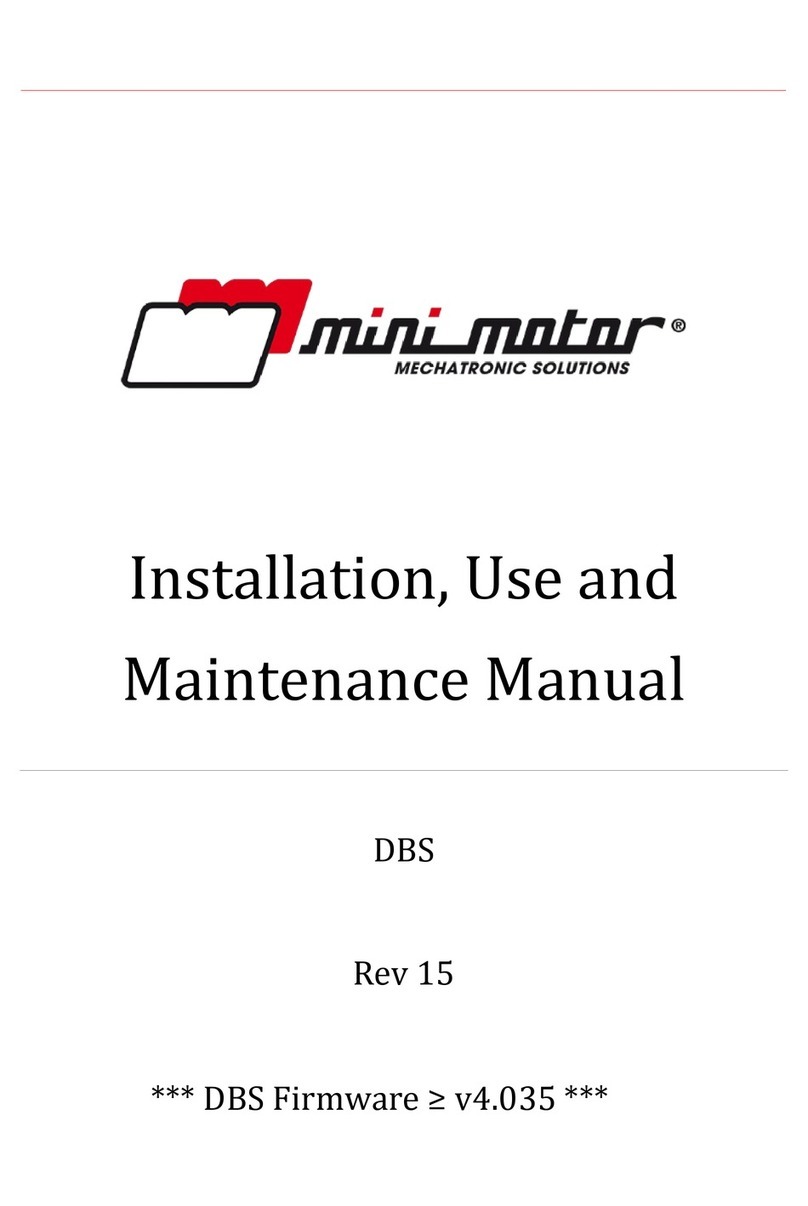
Mini Motor
Mini Motor DBS Series Installation, use and maintenance manual
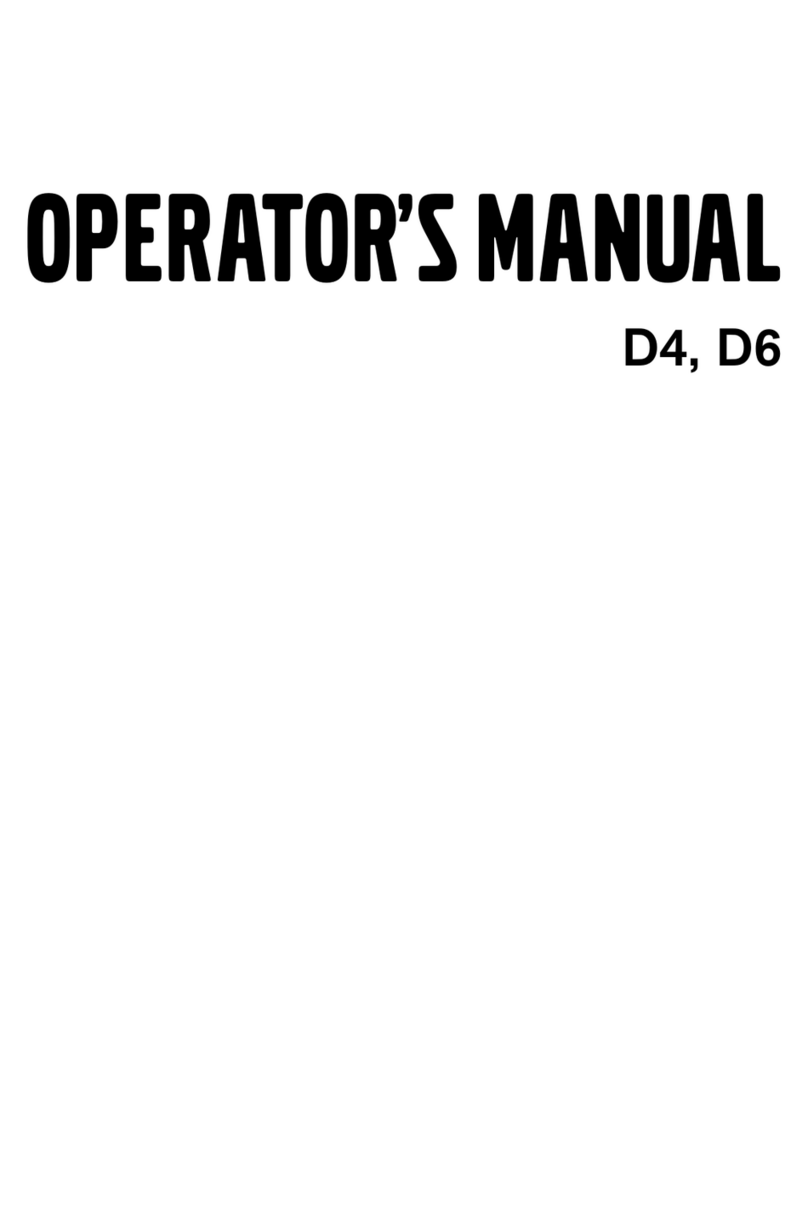
Volvo
Volvo D4 Operator's manual
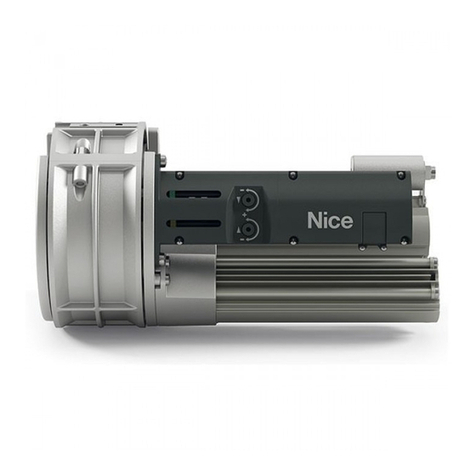
Nice
Nice Rondo RN2010 manual
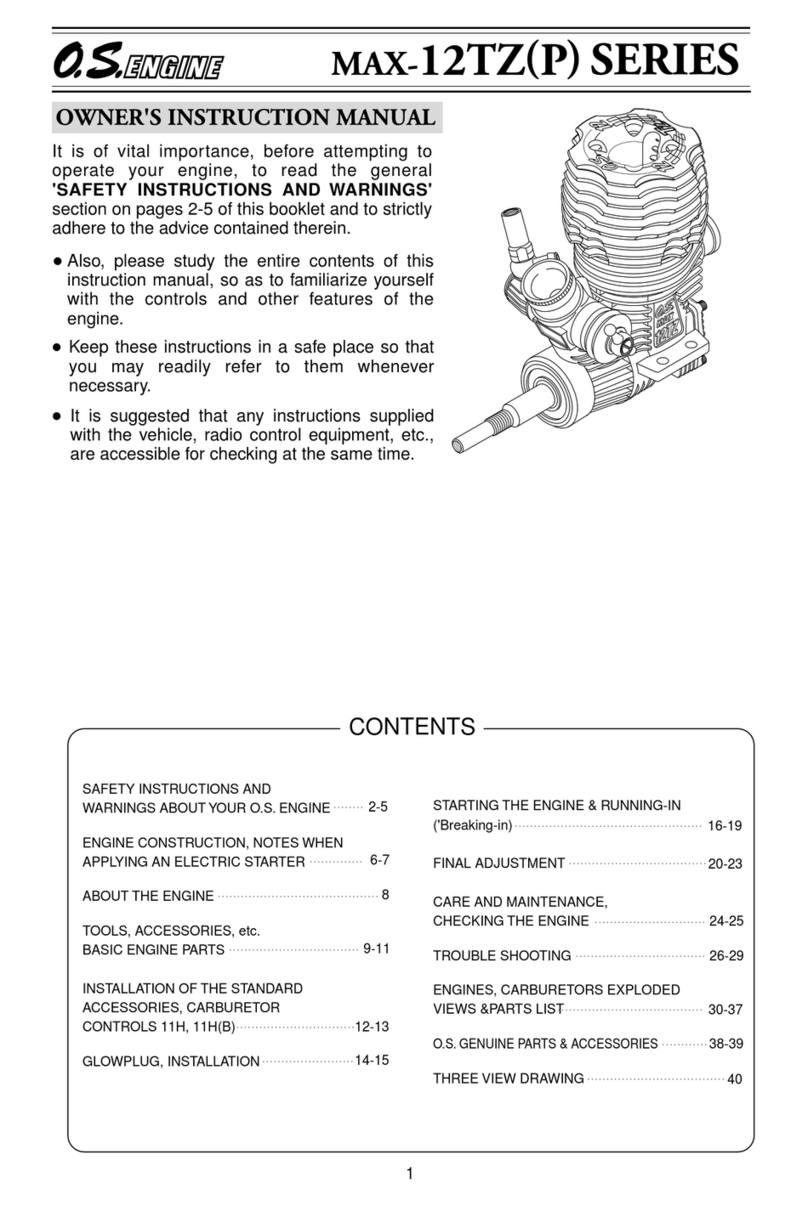
O.S. engine
O.S. engine max-12TZ series Owner's instruction manual

Man
Man E0834 E302 Maintenance manual
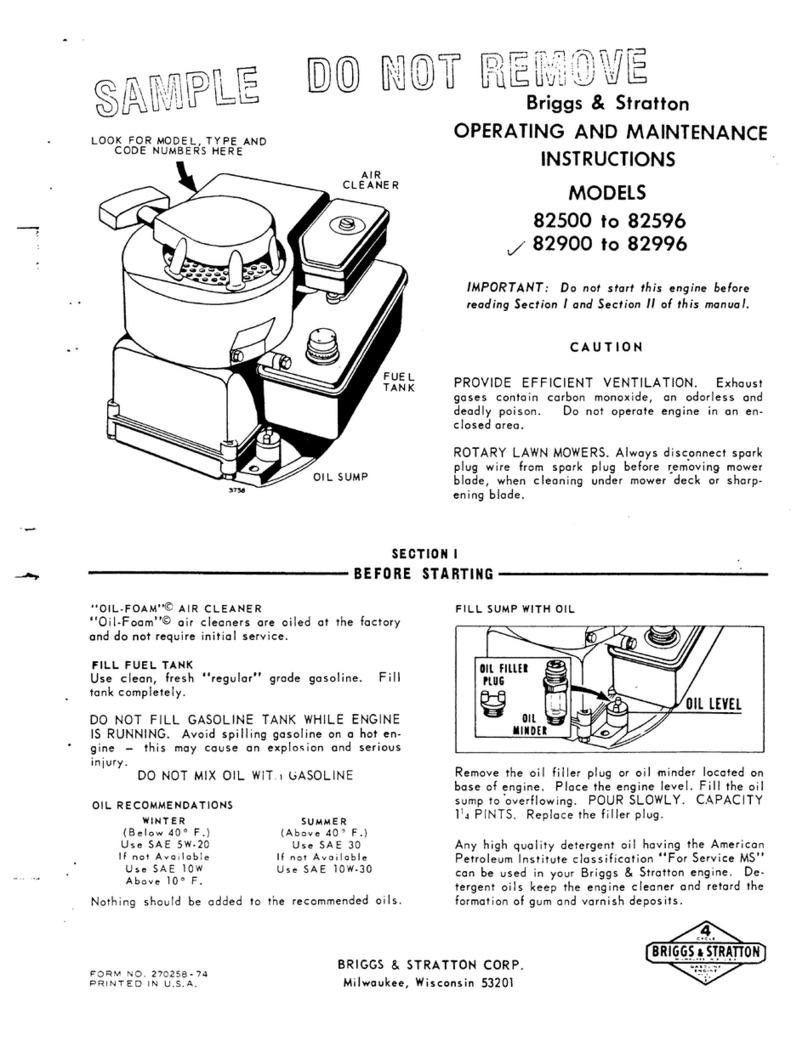
Briggs & Stratton
Briggs & Stratton 82500 Operating and maintenance instructions
